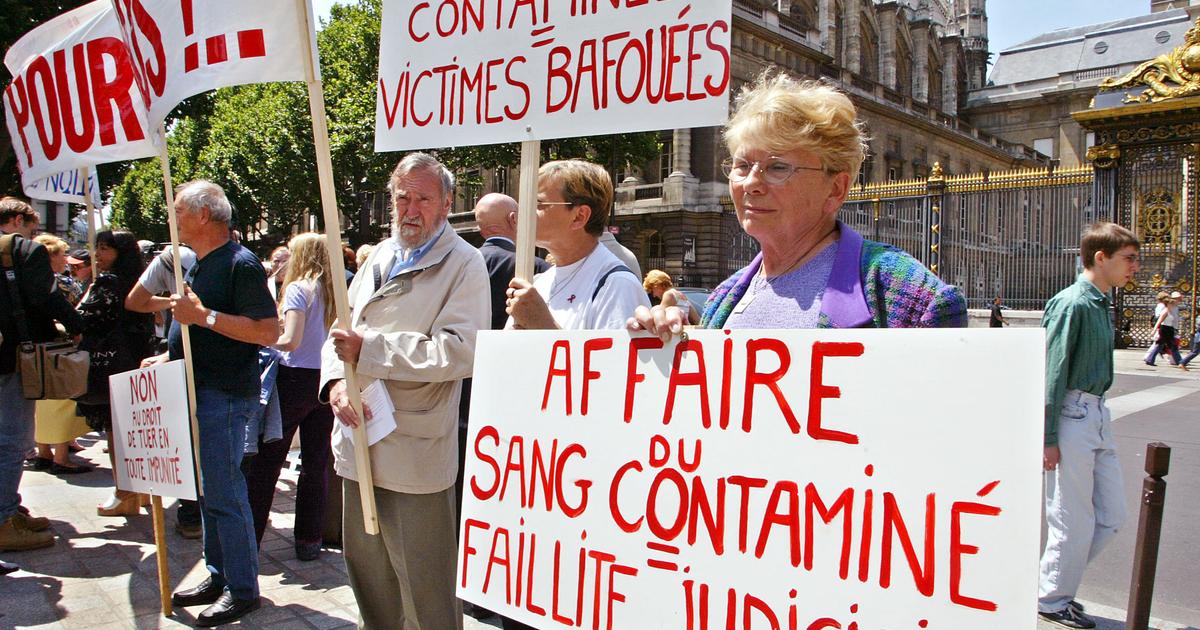“
Responsible but not guilty
”, Georgina Dufoix’s formula has remained in the annals.
It was pronounced on November 4, 1991 on the set of TF1 by the former Minister of Social Affairs in the Fabius government involved in the contaminated blood affair.
It is this same argument that was put forward to the families of the victims during the trial which opened on February 9, 1999 before the Court of Justice of the Republic.
For the first time under the Fifth Republic, three former ministers are tried for crimes or offenses committed in the exercise of their functions.
Seven years earlier, Doctor Michel Garretta, director of the National Blood Transfusion Center, was sentenced to four years in prison.
A look back at this major health scandal.
What is the story of contaminated blood?
The affair began in 1987 with the publication of a series of articles in the magazines
L'Express
then
L'Événement du Jeudi
.
Journalist Anne-Marie Casteret, a trained doctor, reveals that between 1984 and 1985, stocks of blood contaminated by the AIDS virus were sold and used for blood transfusions, particularly for hemophiliacs.
At the time, a study established that half of them in France had been contaminated by the virus identified in 1981. In January 1988, an association of hemophiliacs filed a complaint against the National Blood Transfusion Center (CNTS) while negotiations on compensation are open with insurance companies.
But the real scandal broke out after the revelation on April 25, 1991 by Anne-Marie Casteret in
L'Évènement du Jeudi
of a damning confidential report from the CNTS on a meeting of May 29, 1985. It turns out that the leaders of the center, including President Michel Garretta, have knowingly chosen to sell off their stocks of “
100% contaminated
” blood rather than importing heated blood products from abroad even though they are prescribed by doctors.
This heating technique, which inactivates the virus, has been recommended since 1984 by the scientific community.
“
The distribution of unheated products remains the normal procedure as long as they are in stock
,” Doctor Garretta again reminded his colleagues on June 26, 1985. And if unheated products are no longer reimbursed by Social Security from October 1, 1985, the stocks were not recalled and were distributed to hemophiliacs already seropositive, leading to over-contamination.
Anne-Marie Casteret's article in L'Evénement du Jeudi on April 25, 1991 caused the scandal to break out.
Documentation Le Figaro
Finally, an investigation carried out by the General Inspectorate of Social Affairs (Igas) revealed in September 1991 that systematic screening for the AIDS virus in blood donations had been slowed down for several months while awaiting the development of a French test by Pasteur-Diagnostics.
It was only from August 1, 1985 that screening was made compulsory by a ministerial decree, even though the American Abbott had offered his test in February.
The authorities' inaction caused a scandal and led to two high-profile trials.
Who is involved in the tainted blood affair?
The 1988 complaint resulted in the indictment of several officials.
On June 22, 1992, the trial of doctors Michel Garretta and his deputy Jean-Pierre Allain, Robert Netter, former director of the National Health Laboratory (LNS) and Professor Jacques Roux, former director of public health.
The first two are accused of “
deception regarding the substantial qualities of a commodity
”, and face a sentence of four years in prison.
The other two, charged with “
failure to assist a person in danger
”, risk three months to five years in prison.
Dr. Garretta did not appear in court on October 23, 1992 to hear his sentence to four years in prison with an arrest warrant issued.
A refugee in the United States, he became a prisoner a few days later.
Doctor Allain is sentenced to four years in prison, two of which are suspended, Professor Roux is sentenced to four years suspended, Doctor Netter is acquitted.
The convictions of Garretta and Allain will be confirmed on appeal in 1993, Roux and Netter will be suspended.
Who are the accused ministers?
During the trial, the accused presented themselves as scapegoats and pointed the responsibility from the supervisory authorities to the ministers.
At the end of the year, the Senate and the National Assembly referred suspicions against Laurent Fabius, Prime Minister between 1984 and 1986, Edmond Hervé, his Secretary of State for Health, and Georgina Dufoix to the High Court of Justice. , his minister of social affairs.
The case was closed without further action before the victims filed a complaint again before the Court of Justice of the Republic, created in 1993 to succeed the High Court.
There followed a long judicial investigation entrusted to judge Marie-Odile Bertella-Geffroy which resulted in the indictment of several people for involuntary homicide including Fabius, Dufoix, Hervé but also the former socialist Minister of Health Claude Evin from 1988 to 1991, for not having organized the recall of people transfused before August 1, 1985.
“A poorly understood verdict,” analyzes Le Figaro on March 10, 1999. Le Figaro
Laurent Fabius and Georgina Dufoix, who pleaded ignorance at the time of the events, were acquitted on March 9, 1999, while Edmond Hervé was found guilty of homicide and involuntary injuries, but exempted from sentence.
A snub for the civil parties.
“
Shame on parliamentarians!
» “
Murderous state, complicit justice!
», burst out from the public benches.
“
I have had AIDS for fifteen years.
There is no relief from my illness
,” protests a victim.
On November 6, 2003, Claude Évin obtained a dismissal from the Court of Justice of the Republic.
In 2003, the criminal chamber of the Court of Cassation confirmed the general dismissal of the case of contaminated blood pronounced a year earlier.
Faced with general indignation, the police had to intervene to evacuate the room.

